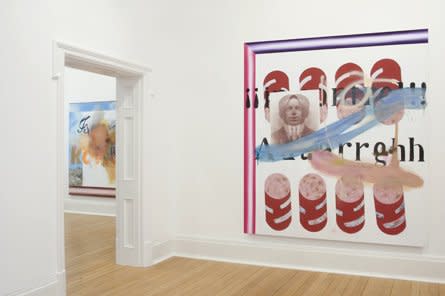Albert Oehlen 29 Feb - 29 Mar 2008 11 Duke Street, St James's
The directors of Thomas Dane are pleased to announce Albert Oehlen's second exhibition at the gallery.
Considered as the heir to a generation of master German painters including George Baselitz, Gerhard Richter and Sigmar Polke, for the past 30 years Oehlen has interrogated and tested the possibilities of painting. A student of Polke, and a contemporary of Martin Kippenberger, Jorge Immendorf and Werner Büttner, he is considered one of the most important painters of his generation.
On the occasion of his second exhibition at the gallery, Albert Oehlen has produced a group of paintings, combining oil, inkjet print collage and spraypaint on canvas. Pop meets punk in this bold body of completely new paintings. Collage elements from German gothic rock magazines in one painting contrasts with blown-up digital prints of Palm Beach in another. With this group of works, the artist 'wanted to do something with advertising images, which was the start of the whole project, but failed', a project which instead shifted into 'free collage'. A cacophony of indecipherable text is haphazardly painted in, snippets of sentences in an array of fonts, taken mainly from lyrics by Scooter, a German techno band, are used as a means of creating a 'sound' or 'atmosphere'. Oehlen explains 'it's not a word/image relation-ship like in a comic book. . . . its just there to give it a smell'.
Well-known motifs return, but in ridiculous guises, such as a crouching Chuckie doll, painted from behind, a portrait made in reverse. Subject matter is chosen for its formal purpose: the texture of sliced salami is as important as its literal reference to consumer so-ciety. Many of the works feature painted pipes running around the border, tromp l'oeil in-dustrial frames akin to those of Ferdinand Leger and Francis Picabia, which seek but fail to contain the explosive content of the rest of the canvas. Lines run through the paintings, cre-ating a vertiginous perspective that is heightened by dirty smears that attempt to obliterate what lies beneath. Oehlen elaborates:
'I worked hard on these stains in the middle of the painting. The cloud of muddy colours takes most of the working time, because I love that: playing with the speed of the whole procedure. Slow it down extremely at a certain point, then start a quick collage-like procedure of putting things together, then suddenly concentrate on col-ours. With a soft brush I was moving the paint for days from one side to the other'.
Oehlen outrightly references Surrealism as one of the first painting practices that actively followed a method, to which he is in debt, rather than the idea of creating fantastic worlds. Duchamp and Dali also loom large, but as painters true to their own method whose prac-tices are acknowledged by Oehlen as means to allow him to make something backwards, and create confusing, uncomfortable situations within the picture plane. The only stable rule in these paintings is that of contradiction. The grand debate between good and bad painting, stupidity and brilliance, and between abstract formalism and expressive figuration all battle it out on the surface of each of Albert Oehlen's significant new paintings.
Editor's Notes
Born in Krefeld, Germany in 1954, Albert Oehlen lives and works in Switzerland and Spain and is professor at the Kunstakademie Düsseldorf. His international exhibitions include ret-rospective exhibitions at the The Whitechapel, London and Arnolfini Bristol (2006), Miami MOCA (2005), solo shows at the Kunsthalle Nürnberg, Nurenberg (2005) Secession, Vienna (2004), Musée Cantonnal de Lausanne (2004), Musée d'Art Contemporain de Strasbourg (2002), Kestner-Gesellschaft, Hanover (2001) and the Kunsthalle Basel (1997).
Full colour catalogue available, with conversation between Nigel Cooke and Albert Oehlen, published by Ridinghouse and Thomas Dane Gallery.



